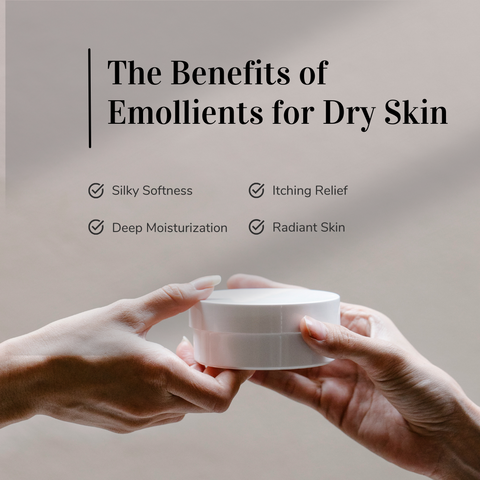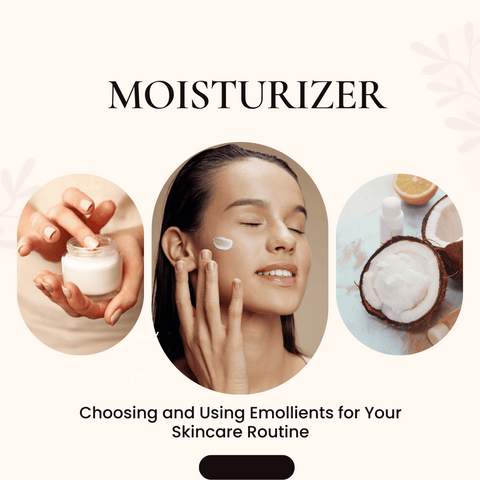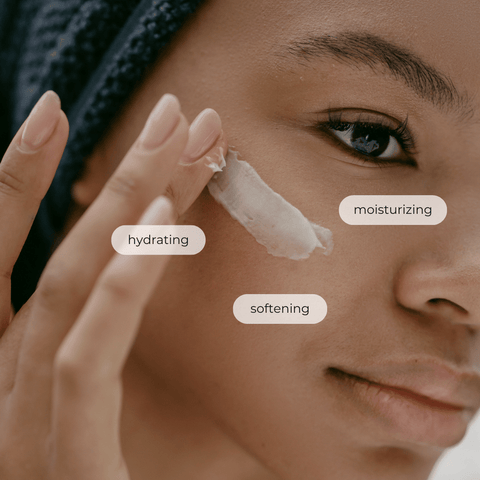Emollients are a helpful remedy for dry skin since they nourish and hydrate the skin, promoting healthier and more pleasant skin. They are essential to skincare routines, especially for people with dry or sensitive skin. This blog delves deeper into emollients, their benefits, and how they operate.
Understanding Emollients: Your Skin's Thirst-Quenching Allies

Emollients are a type of skincare component or product that is used to moisturise and hydrate the skin. They function by producing a protective, hydrating barrier on the skin's surface, preventing water loss, and assisting in the maintenance of the skin's natural moisture levels. Emollients perform various important roles for your skin, including moisture retention, skin softening, barrier enhancement, and irritation reduction. You may maintain a healthy, bright complexion and say goodbye to dry, unpleasant skin by understanding its role and selecting the proper emollients for your skin type and needs. Including emollients in your skincare routine can ensure that your skin looks and feels its best.
What Are Emollients and How Do They Benefit Dry Skin?
The following are the advantages of emollients for dry skin:
-
Moisturization: Emollients are best known for their moisturising properties. They replenish and retain moisture levels in dry skin, providing much-needed hydration. This prevents the skin from becoming dehydrated, flaky, or itchy.
-
Softening: Emollients fill in the gaps between skin cells, making the skin feel smoother and more supple. This softening effect aids in the reduction of roughness and dryness commonly associated with dry skin.
-
Barrier Improvement: Dry skin frequently has a compromised skin barrier, making it more susceptible to external irritants and allergens. Emollients help to protect the skin's natural barrier, lowering the risk of irritation and inflammation.
-
Itching Relief: Dry skin can be itchy and uncomfortable. Emollients can relieve itching and soothe irritated skin, making them useful for conditions such as eczema and psoriasis.
-
Improved Appearance: Regular application of emollients can improve the appearance of dry skin. It helps restore a healthy-looking complexion and radiance, reducing the appearance of fine lines and wrinkles.
How to Use Emollients for Dry Skin:
-
Emollients should be applied liberally to clean, dry skin.
-
To lock in moisture after bathing or showering, apply emollients.
-
Reapply as needed, especially if the weather is dry or harsh.
-
Choose emollients that are appropriate for your skin type and any specific skin concerns you may have.
They hydrate the skin, improve its appearance and comfort, and promote its natural protective functions. You can effectively counteract dryness and maintain healthier, more moisturised skin by integrating emollients into your daily skincare routine.
The Role of Emollients in Strengthening the Skin Barrier
Emollients are necessary for keeping healthy, moisturised, and protected skin by reinforcing the skin barrier. Here's how emollients help with this vital function:
-
Moisture Retention: Emollients form a protective layer on the skin's surface that functions as a barrier against water loss due to evaporation. This sealing effect helps to lock in moisture and keep the skin hydrated. Dry skin frequently lacks this natural barrier, making it more susceptible to moisture loss, which can result in dryness, flakiness, and discomfort.
-
Skin Barrier Repair: Emollients contain lipids and fatty acids that are similar to those present in the natural lipid barrier of the skin. Emollients, when applied topically, can help repair and restore this lipid barrier, which may be damaged or weakened in people with dry skin. This strengthening aids in the retention of moisture and resistance to external irritants and allergens.
-
Prevention of Irritation and Sensitivity: A robust skin barrier works as a shield, shielding the skin from environmental aggressors such as pollution, allergies, and extreme weather. Emollients help to strengthen this defence mechanism, lowering the risk of irritation, redness, and sensitivity that can arise when the skin's barrier is compromised.
-
Soothing and comfort: Emollients have a soothing and calming effect on the skin, relieving the discomfort caused by dryness, irritation, and tightness. They contribute to the creation of a more comfortable and appealing skin texture.
-
Improved Skin Appearance: A healthy skin barrier leads to a more youthful appearance. Emollients soften the skin's surface, making fine lines, wrinkles, and rough spots less visible. This can result in better skin aesthetics and a younger appearance.
-
Enhanced Absorption of Active Ingredients: Emollients can help other skincare products and active chemicals absorb better, allowing them to permeate the skin more efficiently. This synergy might boost the overall efficacy of your skincare programme.
-
Long-term Skin Health: Emollients help to preserve the skin's barrier function throughout time, which contributes to long-term skin health. Emollients can help prevent chronic dry skin disorders and maintain a balanced complexion by reducing moisture loss and boosting the skin's natural protective mechanisms.
How Emollients Work to Provide Lasting Moisturization
Emollients promote long-lasting moisturization by establishing a protective barrier on the skin's surface that aids in the retention of moisture and the prevention of water loss. Their distinct qualities and functions contribute to their ability to keep skin hydrated for an extended period of time. Emollients achieve long-lasting moisturization in the following ways:
-
Barrier Formation: Emollients have a rich, creamy, or greasy texture that makes them easy to apply to the skin. When applied to the skin, they form a thin, occlusive barrier. This barrier acts as a protective layer, sealing in the skin's natural moisture and preventing water from evaporating into the surroundings.
-
Reduction of Transepidermal Water Loss (TEWL): The process through which water escapes from the skin's surface into the air is known as transepidermal water loss (TEWL). It is a typical problem for people who have dry skin. Emollients function as a barrier, reducing TEWL and effectively retaining moisture within the skin.
-
Hydration Retention: Emollients are moisturising compounds that contain lipids, fatty acids, and humectants (such as glycerin or hyaluronic acid). These chemicals combine to attract and hold water molecules in the skin.
-
Smoothing and Softening: Emollients have a surface smoothing and softening impact on the skin. They fill in the spaces between skin cells, which is especially good for people who have rough or dry skin. The smoother skin surface improves moisture retention and delivers a more pleasant and supple feel.
-
Long-Lasting Effects: Emollients give long-lasting hydration. Emollients, as opposed to certain lightweight moisturisers, can keep the skin moisturised and comfortable for an extended period of time. This is especially useful in instances where applying skincare frequently is impractical, like throughout the day or at night.
-
Versatile Formulations: Emollients are available in a variety of forms, including creams, lotions, ointments, and oils. Individuals can select the formulation that best suits their skin type and preferences, ensuring that they get the long-lasting hydration they want.
-
Compatibility with Other Products: Emollients can be combined with other skincare products like serums, sunscreen, and cosmetics. They frequently improve the efficiency of these treatments by providing a smooth canvas for application and allowing for improved product absorption.
-
Skin Barrier Support: Emollients help to preserve the skin's natural barrier function, which is essential for keeping it hydrated and protecting it from external irritants, pollutants, and allergens.
To achieve lasting moisturization with emollients, it's essential to incorporate them into your daily skincare routine. Applying emollients liberally to clean, dry skin and using them on a regular basis will help keep your skin hydrated, comfortable, and protected against dryness and environmental stressors.
The Benefits of Emollients for Dry Skin

Emollients provide a wide range of advantages for dry skin, making them crucial components of dry skin skincare regimes. Moisturization, softening, barrier enhancement, irritation prevention, itching relief, enhanced skin look, long-lasting hydration, adaptability, compatibility with other products, and skin comfort are among the benefits. You may effectively counteract dryness and maintain healthier, more moisturised, and more pleasant skin by integrating emollients into your regular skincare routine.
Replenishing Dry Skin: The Nourishing Power of Emollients
Emollients have several important benefits for dry skin:
-
Deep Moisturization: Emollients are moisture champions. They replenish and maintain optimal moisture levels by infusing the skin with much-needed hydration. This helps to prevent dryness, flakiness, and that unpleasant tight feeling.
-
Silky Softness: Emollients improve the texture of the skin by smoothing and softening it. They fill in the gaps between skin cells, creating a smoother, suppler, and more touchable skin surface.
-
Strengthening the Skin Barrier: Dry skin frequently has a compromised skin barrier, making it prone to irritation and moisture loss. Emollients strengthen the skin's natural barrier, reducing sensitivity and aiding moisture retention.
-
Itching Relief: The soothing properties of emollients provide relief from the itching and discomfort that frequently accompany dry skin conditions such as eczema or psoriasis.
-
Radiant Skin: Emollients can help your skin regain its natural radiance. They reduce the appearance of fine lines, wrinkles, and dullness by moisturising and smoothing the skin.
-
Long-lasting Hydration: Emollients form a protective shield on the skin's surface, locking in moisture and preventing water from evaporating. This results in long-lasting hydration, keeping your skin comfortable all day.
-
Versatile Formulations: Emollients are available in a variety of formulations to accommodate different skin types and preferences. There is an emollient for everyone, whether you prefer a creamy lotion or a rich ointment.
-
Product Compatibility: Emollients work well with other skincare products. You can easily incorporate them into your skincare routine, boosting the efficacy of serums, sunscreens, and makeup.
Their ability to lock in moisture, smooth the skin's surface, and support the skin's natural barrier is what gives them their nourishing power. By incorporating emollients into your skincare routine, you can say goodbye to dry skin and reveal healthier, glowing, and nourished skin.
Alleviating Itchiness and Soothing Dry Patches with Emollients
Emollients provide a multifaceted approach to itch relief and dry patch relief, including moisture restoration, skin barrier repair, calming feeling, smoothing texture, and barrier protection. Here's how to use emollients properly for pain relief:
-
Choose the Right Emollient: Look for emollients that are specifically formulated for dry or sensitive skin. Look for ingredients that are known for their soothing and hydrating properties, such as ceramides, shea butter, or natural oils like coconut oil.
-
Cleanse Gently: Before applying emollients, gently cleanse the affected areas with a mild, fragrance-free cleanser. Hot water, which can further dry out the skin, should be avoided.
-
Apply Emollients Liberally: Apply emollients liberally to dry patches, ensuring thorough coverage. Apply with clean fingers or a soft cotton pad.
-
Consistency is Key: Apply emollients regularly, multiple times a day if needed, to maintain hydration and provide ongoing relief.
-
Avoid Scratching: As tempting as it may be, avoid scratching dry patches because it can aggravate irritation and further damage the skin.
-
Consult a Dermatologist: If the dry patches persist or worsen, see a dermatologist. They can customise a treatment plan for you or recommend prescription-strength emollients for more severe cases.
Finally, emollients are a valuable tool for relieving itchiness and soothing dry skin patches. Their ability to restore moisture, repair the skin barrier, and provide immediate relief makes them indispensable for people suffering from dry skin. You can enjoy a more comfortable and irritation-free experience by incorporating emollients into your skincare routine.
Tackling Sensitivity and Irritation: Emollients to the Rescue
Emollients are useful in the treatment of sensitivity and irritation because of their skin-soothing and barrier-strengthening properties:
-
Moisture and Hydration: Emollients are moisture-rich formulations that hydrate the skin immediately. This helps to relieve dryness, which is a common cause of sensitivity and irritation.
-
Barrier Repair: Emollients contain lipids and fatty acids that are similar to those found in the skin's natural barrier. When applied topically, they help to repair and strengthen the skin barrier, lowering the risk of moisture loss and irritant penetration.
-
Barrier Protection: Emollients form a protective barrier on the skin's surface, acting as a shield against environmental irritants, pollutants, and allergens. This barrier protection is especially important for sensitive skin, which is more prone to external triggers.
-
Calming and Soothing: Emollients have a soothing and calming effect on the skin. They can provide immediate relief from sensitivity and irritation-related itching, burning, or stinging sensations.
-
Texture Improvement: Emollients smooth the skin's surface by filling in gaps between skin cells. This can improve skin comfort by reducing roughness and uneven texture.
-
Healing Support: Emollients help the skin's natural healing process by creating a healing environment. They reduce friction, protect the skin from further damage, and promote skin repair.
They are essential tools for achieving a more comfortable and balanced complexion because of their ability to provide moisture, strengthen the skin barrier, soothe discomfort, and protect against external irritants. Emollients should be used in your skincare routine to protect your skin from sensitivity and irritation.
Choosing and Using Emollients for Your Skincare Routine

This guide will assist you in selecting and using emollients effectively in your skincare regimen.
-
Understand Your Skin Needs: Assess your skin type and individual concerns before choosing emollients. Determine whether you have dry, sensitive, oily, or mixed skin and any specific skin issues you want to address (for example, dryness, sensitivity, aging, or acne). Understanding your skin's requirements will help you choose the best emollients.
-
Choose the Right Emollient: There are several sorts of emollients, and choosing the proper one for your skin is critical. Consider the following alternatives based on your skin type and concerns: dry skin, sensitive skin, oily or acne-prone skin, and combo skin.
-
Integrate Emollients into Your Routine: Emollients should be used in your regular skincare routine to reap the most advantages. Here's how: cleanse, tone, apply emollients, layer, and apply sunscreen.
-
Consider Your Skin's Needs Throughout the Day: Reapply emollients as needed, especially if your skin is extremely dry or sensitive. Emollients can be used as a touch-up throughout the day to maintain moisture and comfort.
-
Monitor and Adjust: Take note of how your skin reacts to the emollient you're using. Consider trying an alternative product if it does not produce the expected outcomes or creates bad effects.
-
Consult a Dermatologist: Consult a dermatologist if you have specific skin issues or conditions, or if you're unclear about which emollients to use. They can make tailored recommendations and address any underlying skin problems.
Finding the Right Emollients: Key Ingredients to Look For
Understanding the important elements that can address certain concerns is essential when selecting the proper emollients for your skincare requirements. Emollients are available in a variety of formulations, with the active ingredients determining their effectiveness. When shopping for emollients, look for the following key ingredients:
-
Shea Butter: Shea butter is a rich, moisturising emollient obtained from the shea tree's nuts. It is well-known for its ability to give deep hydration, making it an excellent solution for dry and sensitive skin.
-
Ceramides: Ceramides are lipids present naturally in the skin's outermost layer. Ceramide-containing emollients aid in the restoration and strengthening of the skin's barrier, making them excellent for people with damaged or dry skin.
-
Glycerin: Glycerin is a humectant emollient that draws and binds moisture from the environment to the skin. It helps to keep skin hydrated and is suitable for all skin types.
-
Hyaluronic Acid: Hyaluronic acid is a highly effective humectant that can store 1,000 times its weight in water. Hyaluronic acid emollients provide intensive hydration while plumping the skin and decreasing the appearance of fine lines and wrinkles.
-
Natural Oils: Natural oils high in fatty acids and antioxidants include jojoba oil, argan oil, and avocado oil. These oils are excellent for all skin types and provide moisturising and nourishing benefits.
-
Aloe Vera: Aloe vera is a moisturising and calming substance with anti-inflammatory qualities. Aloe vera emollients are effective for soothing and relieving skin irritation.
-
Chamomile: Chamomile is another calming component that is commonly included in emollients. It soothes sensitive and irritated skin by reducing redness and inflammation.
-
Oat Extract: Oat extract includes components that are both soothing and protective to the skin. Emollients containing oat extract are especially good for people who have sensitive or eczema-prone skin.
-
Allantoin: Allantoin is a gentle ingredient well-known for promoting skin healing and repair. It is commonly found in emollients used to relieve dryness and irritation.
-
Dimethicone: Dimethicone is a silicone-based emollient that forms a protective layer on the surface of the skin. It prevents moisture loss and is ideal for people with dry or sensitive skin.
-
Beeswax: Beeswax is a natural emollient that provides the skin with a protective and hydrating barrier. It is commonly used to keep moisture in lip balms and creams.
-
Petrolatum (Vaseline): Petrolatum is an occlusive emollient that forms a protective seal on the skin to prevent moisture loss. It works wonders on extremely dry or chapped skin.
Consider your skin type, specific concerns, and any allergies or sensitivities you may have when selecting an emollient. Additionally, reading product labels and researching the ingredients can assist you in locating emollients that are best suited to your skincare requirements. A dermatologist can also provide personalised advice on choosing the best emollients for your skin.
Incorporating Emollients into Your Daily Skincare Routine
Emollients can help you achieve and maintain well-hydrated, pleasant, and healthy-looking skin by incorporating them into your daily skincare routine. Here's a step-by-step tutorial on doing it correctly:
-
Start with a Gentle Cleanser: To begin your skincare routine, cleanse your face with a gentle, fragrance-free cleanser. Cleaning removes dirt, makeup, and pollutants from your skin without removing its natural oils.
-
Apply a Toner (Optional): If you use a toner, apply it after cleansing. Look for a toner with moisturising and calming properties to prepare your skin for emollient application.
-
Choose the Right Emollient: Choose an emollient that is suitable for your skin type and addresses your specific concerns. Consider your skin's dryness, sensitivity, and any other skin issues you may have.
-
Generously Apply Emollient: Apply a very small amount of your chosen emollient to clean, dry skin. Massage it into your skin in upward, circular motions. If desired, apply emollient to the neck and décolletage.
-
Consider Targeted Treatment (Optional): If you have specific skincare concerns, such as acne, fine wrinkles, or hyperpigmentation, you can supplement your emollient with serums or spot treatments. Allow each product to absorb before moving on.
-
Use Sunscreen (Daytime): Finish your daily skincare routine with an SPF 30 broad-spectrum sunscreen. Sunscreen is essential for preventing UV damage and premature skin aging.
-
Reapply Emollient as Needed: Consider reapplying emollient throughout the day, especially if your skin is extremely dry or sensitive. Keep a small bottle of water on hand for on-the-go hydration.
-
Evening Routine: Your evening skincare regimen may differ slightly. As your final step after cleansing, apply an emollient to lock in moisture and aid your skin's natural repair processes while sleeping.
-
Exfoliation (Weekly or as Needed): Exfoliation can be added to your routine once or twice a week, depending on your skin type and problems. To produce a smoother complexion, use a gentle exfoliator to remove dead skin cells. After exfoliating, apply your emollient.
-
Consult a Dermatologist: Consider contacting a dermatologist if you have specific skin disorders, chronic concerns, or are unclear about which emollients to use. They can make personalised recommendations and treat any underlying skin issues.
Expert Tips for Maximising the Benefits of Emollients
Expert ideas and practises are required to maximise the benefits of emollients in your skincare routine. Here are some helpful suggestions to help you get the most out of these skin-care products:
-
Apply Emollients to Damp Skin: Consider applying emollients to slightly damp skin for improved absorption, especially after cleansing or bathing. This can help to better seal in moisture.
-
Layer Emollients with Other Products: Emollients can be used in conjunction with other skincare products. Layer serums, treatments, or moisturisers as needed after applying your emollient. Emollients can serve as a protective basis for succeeding products, allowing them to penetrate more efficiently.
-
Customise Your Routine: Make your emollient application appropriate to the needs of different areas of your face or body. Some places may demand a heavier emollient than others.
-
Use Emollients for Dry Cuticles and Hands: Emollients can do wonders for dry cuticles and hands. Apply a small amount to your cuticles and massage them into your hands to keep them soft and moisturised.
-
Apply Emollients to Dry Feet and Heels: Treat your feet to some emollient love, especially on dry or cracked heels. Apply a thicker emollient before bedtime, cover with socks, and wake up to softer feet.
-
Embrace Emollients as Overnight Masks: For an intense hydration boost, use emollients as overnight masks. Apply a generous amount to your face, neck, or hands before bed to wake up with deeply nourished skin.
-
Reapply as Needed: Don't hesitate to reapply emollients throughout the day, particularly if you have extremely dry or sensitive skin. A small touch-up can make a big difference in maintaining hydration.
-
Mix Emollients with Other Products: Customise your skincare routine further by mixing a few drops of your favourite emollient with your foundation or tinted moisturiser for a radiant, dewy finish.
-
Be Mindful of Product Order: Pay attention to the order in which you apply your skincare products. Typically, emollients come after serums and treatments but before sunscreen during the daytime.
-
Stay Consistent: Consistency is key to maximising the benefits of emollients. Use them regularly in your skincare routine, both day and night, to maintain skin hydration and comfort.
-
Monitor Your Skin: Keep an eye on how your skin responds to emollients. If you notice any adverse reactions or sensitivity, discontinue use and consult a dermatologist.
-
Stay Hydrated and Protect Your Skin: Hydrated skin starts from within. Drink plenty of water to maintain overall skin health. Additionally, protect your skin from excessive sun exposure, cold weather, and harsh environmental conditions.
-
Read Product Labels: Learn about the ingredients in the emollients you've chosen. Look for formulas that are appropriate for your skin type and issues, and avoid products that contain components to which you may be allergic.
By incorporating these expert tips into your skincare routine, you can make the most of emollients and enjoy their full range of benefits, including enhanced hydration, comfort, and overall skin health.
Emollients: Unlocking the Secrets to Healthy and Hydrated Skin

Emollients are the unsung heroes of skincare, and they hold the key to healthy, moisturised, and comfortable skin. These multifunctional products and substances work their magic by retaining moisture, improving the skin's barrier, and giving a calming touch. Understanding emollients, the science behind emollients, emollients for different skin types, emollients, and skin conditions, navigating ingredients, incorporating emollients into your routine, the secret to lasting moisturization, expert tips for emollient mastery, and consultation with dermatologists are some of the secrets to their effectiveness in skincare.









































